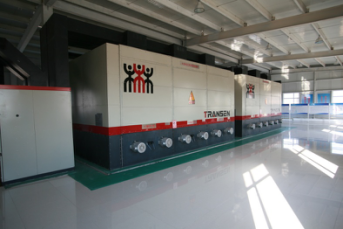An axial piston pump works by utilizing a change in volume caused by a reciprocating movement of a plunger in a plunger bore parallel to the drive shaft. Because the plunger and the plunger hole are all circular parts, high accuracy can be achieved during processing. Therefore, the volumetric efficiency is high, the operation is smooth, the flow uniformity is good, the noise is low, the working pressure is high, but the hydraulic oil is contaminated. More sensitive, more complex structure, higher cost.
Axial piston pump configuration:
Axial piston pump 1 - handwheel; 2-screw; 3-variable piston; 4-swash plate; 5-pin; 6-return plate; 7-shoe; 8-ram; 9-middle pump body; 10-Front pump body: 11-front bearing; 12-displacement plate; 13-axis; 14-centering spring; 15-cylinder body; 16-big bearing; 17-ball.
Axial piston pump classification:
MCY14-1B: Dosing plunger pump SCY14-1B: Manually variable plunger pump YCY14-1B: Pressure variable plunger pump MYCY14-1B: Rating variable plunger pump B14-1B: Electro-hydraulic controlled plunger pump PCY14-1B: Constant Pressure Variable Piston Pump Axial Piston Pump Operating Principles and Performance Features Axial piston pumps are generally composed of main components such as cylinders, oil pans, plungers, and swashplates (Figure 1-40). The cylinder body has a plurality of plungers, and the plungers are arranged axially, that is, the center line of the plunger is parallel to the axis of the transmission shaft, so it is called an axial plunger pump. However, it is different from the reciprocating piston pump because its plunger not only reciprocates within the pump cylinder, but also has a relative rotational movement between the plunger and the pump cylinder and the swash plate. The plunger contacts the swash plate with a spherical tip. There are high and low pressure moon grooves on the oil pan. They are separated from each other by partition walls to ensure certain sealing properties. They communicate with the pump inlet and outlet respectively. There is a slant angle between the axis of the swash plate and the cylinder axis.
The working principle of the axial piston pump, when the motor drives the transmission shaft to rotate, the pump cylinder and the plunger rotate together, and the plunger head always maintains contact with the swash plate, because the swash plate forms an angle with the cylinder body, so when the cylinder body rotates, The plunger reciprocates in the pump cylinder. Taking the next plunger of Fig. l-40 as an example, it turns from 0° to 180°, that is, to the position of the upper plunger, the plunger cylinder volume gradually increases, so the liquid is sucked through the oil suction port of the oil pan. Human cylinder; while the plunger is rotated from 180° to 360°, the plunger cylinder volume gradually decreases, so the liquid in the cylinder discharges liquid through the outlet of the distribution pan. As long as the shaft rotates, the pump will continue to work.
By changing the angle of the tilting element, the stroke length of the plunger in the pump cylinder can be changed and the flow rate of the pump can be changed. The constant tilt angle is called a fixed displacement pump, and the tilt angle can be changed as a variable displacement pump.
Axial piston pumps vary according to the tilting element. They are swashplate type and inclined axis type.
The swash plate type has a tilting angle of the swash plate relative to the rotating cylinder, which causes the plunger to reciprocate in the pump cylinder. The axis of the drive shaft and the axis of the cylinder are the same. This kind of structure is simpler, and the rotation speed is higher, but the working conditions are required to be high. The contact portion between the plunger end and the swash plate is often a weak link. The inclined axis of the swash plate is consistent with the axis of the drive shaft. It is because the plunger cylinder tilts an angle with respect to the drive shaft to cause the plunger to reciprocate. Flow adjustment depends on swinging the angle of the plunger cylinder, so it is also called swing cylinder type. Compared with swashplate type, it has reliable operation, large flow, but complicated structure.
Axial piston pump and radial piston pump, the discharge pressure is high, it can generally work in the range of 20 ~ 50MPa, high efficiency, small radial size, compact structure, small size, light weight. However, the structure is more complex than the radial piston pump, which requires high processing and manufacturing costs.
Axial piston pumps are generally used in hydraulic drive systems for machine tools, metallurgy, forging, mining, and hoisting machinery, and are particularly widely used in high-power hydraulic drive systems. In order to increase the efficiency, a gear pump or a vane pump is also commonly used as an auxiliary oil pump for the application of oil to compensate for leakage and maintain a certain pressure in the oil circuit.
Central Heating Electric Boiler
Our central heating electric boiler make good use of electric power cost between on-peak and off-peak , heating system economy of running is enhanced. The boiler can be used for residence buildings, hospitals, super market and shopping malls heating.
The boiler has no discharge, well-knit structure, less land occupation, convenient installation.
Specifications
High temperature heat storage
High efficiency
Full-automatic control
Related Products:intelligent electric boiler,intelligent heat storage electric boiler,wind power heat storage machine.

Central Heating Electric Boiler
Central Heating Electric Boiler,High Voltage Central Heating Electric Boiler,Swimming Pool Heating Boiler,Wind Electric Central Heating Boiler
Dalian Transen Technology Co.,Ltd. , http://www.transen-china.com
![<?echo $_SERVER['SERVER_NAME'];?>](/template/twentyseventeen/skin/images/header.jpg)